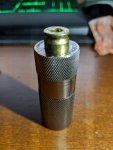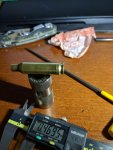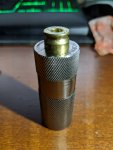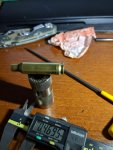I'll start off by saying I am new to the forum, new to long range shooting, and VERY new to reloading (produced my first batch of 6.5 Creedmoor less than a month ago.)
Relevant pieces of my current setup that I used to process a bunch of brass yesterday:
Redding Big Boss II w/ Hornady LnL "quick change" adapters
Lee Precision universal sizing die
Hornady Match seating die w/ Microjust, ELDx stem. (I also own the FL die, but have not purchased neck bushings.)
Redding Imperial sizing wax for the body, OneShot for the insides of the necks
Hornady 6.5CM case gauge
Redding FL sizing die (base model)
Hornady Custom FL die (sent back to Amazon)
Now I'll describe the issue I am running into...
Some of my brass, after being put through sizing dies will get hung up in the case gauge. I will wind up with between 1mm and 5mm poking up! While I am running the brass in and out (with any of the dies I have used over the past several weeks) I notice that I have considerable resistance going in, and coming out. (Of course this is with a squeaky clean gauge, and I've wiped lube off of the brass.)
I did some experimenting, found that when I remove the expander I have a much greater success rate.
I tried moving the expander back a ways with my new Redding die, this made no difference.
Then I tried moving the expander "rod" back in my Lee Precision die - - This did the trick! I had a MUCH better success rate. Brass requires an average amount of force on the way in, then there's maybe a tiny bit on the way out. Out of about six hundred pieces that I processed yesterday, I ended up with ~15 that I could not get to drop into and out of my gauge checker.
Photo is of one of the more extreme cases of "bulge." Most of the throw-backs that I ran into yesterday had about 1-2mm of case head sticking up. I think the reading on my micrometer is maybe the widest point... but I might be wrong... (that is actually in spec??)


Now that I am typing this all out in one place, this sounds like inadequate lubrication - - I am hand-lubing the bodies of the cases w/ the Redding Imperial wax, and using two passes of 45* OneShot for the insides... If there's not enough lubrication, I might be mushrooming my cases out near the base.
What do you all think?
Relevant pieces of my current setup that I used to process a bunch of brass yesterday:
Redding Big Boss II w/ Hornady LnL "quick change" adapters
Lee Precision universal sizing die
Hornady Match seating die w/ Microjust, ELDx stem. (I also own the FL die, but have not purchased neck bushings.)
Redding Imperial sizing wax for the body, OneShot for the insides of the necks
Hornady 6.5CM case gauge
Redding FL sizing die (base model)
Hornady Custom FL die (sent back to Amazon)
Now I'll describe the issue I am running into...
Some of my brass, after being put through sizing dies will get hung up in the case gauge. I will wind up with between 1mm and 5mm poking up! While I am running the brass in and out (with any of the dies I have used over the past several weeks) I notice that I have considerable resistance going in, and coming out. (Of course this is with a squeaky clean gauge, and I've wiped lube off of the brass.)
I did some experimenting, found that when I remove the expander I have a much greater success rate.
I tried moving the expander back a ways with my new Redding die, this made no difference.
Then I tried moving the expander "rod" back in my Lee Precision die - - This did the trick! I had a MUCH better success rate. Brass requires an average amount of force on the way in, then there's maybe a tiny bit on the way out. Out of about six hundred pieces that I processed yesterday, I ended up with ~15 that I could not get to drop into and out of my gauge checker.
Photo is of one of the more extreme cases of "bulge." Most of the throw-backs that I ran into yesterday had about 1-2mm of case head sticking up. I think the reading on my micrometer is maybe the widest point... but I might be wrong... (that is actually in spec??)


Now that I am typing this all out in one place, this sounds like inadequate lubrication - - I am hand-lubing the bodies of the cases w/ the Redding Imperial wax, and using two passes of 45* OneShot for the insides... If there's not enough lubrication, I might be mushrooming my cases out near the base.
What do you all think?





